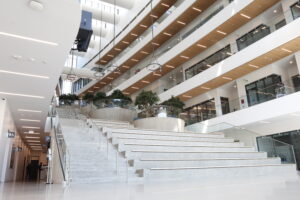Written by: Gene Cole, Opinions Editor
Recently, SFU students got an email reminding them of proper procedure in an emergency, providing the phone numbers for security on each campus. This came after two separate safety and security crises on Burnaby campus. In one case, an assault occurred in a classroom; in another, a student passed away in a sudden mid-exam medical emergency.
Many students reacted to the assault on Facebook and SFU’s Reddit community. These ranged from concern for their peers’ safety to frustration with SFU and its security service. When a student passed away later that month, it directed even more student eyes toward SFU’s general emergency services and protocol. The questions students have been asking along the lines of “Why don’t all classrooms have lockable doors?” to “Why didn’t the students or security get more involved?”
I wasn’t present for or affected by these events, but in reading through these recent criticisms leveled at SFU, I fully agree that our emergency services have shown major problems. I know many who have had ongoing challenges with security outside of these situations, but these have been examples of significant problems with how our school responds to major emergencies.
That said, while these events have certainly pointed out areas of improvement for the school, I don’t think there’s much we’re likely to see change. There are a long list of limitations on what SFU can actually do differently that come from the nature of our emergency policy, our security system, and Burnaby campus itself.
Security responded properly, but not fast or effective enough
Campus Public Safety (CPS) functions as a response system to contact regular authorities. It supplies private security guards and manages the situation until police, paramedics, or the fire department can take over. According to the safety email, students are supposed to call security before 9-1-1. This was also mentioned by Tim Rahilly, vice-provost and associate vice-president, students and international, in response to the medical emergency.
The problem with this protocol on who to call first, though, is that it requires students to put more trust into our security service than emergency services that can take greater action, which is hard to do when there’s a limit to how much CPS can intervene. Unlike cops or paramedics, CPS personnel don’t have the resources or legal ability to deal with every situation themselves.
Unfortunately, SFU Burnaby is located on a mountaintop and is far away from police, fire, and hospital services, which means calling 9-1-1 is not always a time-effective solution. On the other side, it would be unreasonably costly to try and establish on-campus resources that are as effective as police officers and paramedics. The campus public safety personnel we have is the most reasonable middle ground.
If security really can’t work much faster in the moment, then we can at least do better in the aftermath
What the school can and should do is give proper care and concern to situations like these afterward, ensuring that they quickly and consistently follow up with students, staff, and others affected.
After the assault case, Ashley Lee, a student present during the assault incident, spoke out on Facebook about how there was no communication with her peers or the prof immediately after the event. SFU did eventually respond, but only after Lee’s professor requested that they do so.
What they did receive was reportedly fully insufficient. According to Lee on Facebook, “A psychologist who was supposedly the head of SFU Health and Counselling along with a security officer came to our class and basically told us the situation wasn’t that bad and we were all overreacting. They made us feel small and insignificant.”
Eergency protocol absolutely has to change so that the school can send greater health and counselling resources. The school’s health and counselling representatives should be more sympathetic and empathetic to what students have gone through. The school needs to be more proactive in delegating those representatives, and I’m confident the school is capable of this change.
That being said, the school seems to have provided such resources much faster to students present during the medical emergency. In an interview with The Peak, Rahilly claimed that SFU claimed had reached out to affected students to offer health and counselling services after the event, and also stated that they would be willing to make academic accommodations for those unable to complete their exam properly. Maybe this is a sign of improvement, or maybe not — it’s hard to say with just two incidents — but it might be a reason to have hope.
SFU also claimed to be putting together a larger review of safety and security protocol following the medical emergency, which will ideally help emergency responding to be far more consistent. SFU does seem to be trying to learn how to better support students, but under the circumstances, it feels like too little, too late.
It’s easy to criticize students’ inaction, but honestly, students shouldn’t be expected to know how to react
Some comments in the Facebook post on the assault talk about how people should have taken action and how disappointing it was that nobody helped. I do think there’s a rationality to it, but I would still consider these to be unfair responses.
An emergency situation is difficult to handle as a bystander. The bystander effect is a real psychological phenomenon; it’s challenging for people in the middle of an emergency to intervene, and some may also be concerned about making things worse. As a result, there’s only so much that we can do as witnesses at times, and it isn’t a student’s responsibility to take charge.
Even so, giving students more information and resources couldn’t hurt
It’s fair to say many students aren’t instructed well as to how they should respond in an emergency. Few people know what numbers to call, and one of the only ways those have been actively provided was in the SFU-wide email that was sent out after the recent emergencies took place.
A way to remedy this would be to give safety information in each lecture at the start of the semester. This way, students will know the best available courses of action in any given room of the school, either for their own safety or for the safety of others. In practice, most students might tune out, treating it as another dull part of reviewing the syllabus, but even so, something this minor could teach people what they need to know if worst comes to worst.
Final thoughts
While there are a lot of reasonable safety measures students could ask SFU to implement, our current system is far from nothing. There isn’t a big easy fix for SFU’s less-than-ideal emergency responses; despite that, there are definitely flaws we can address.















[…] the years, there have been increasing concerns about the response of SFU Safety & Risk Services (SRS) to campus incidents. Most recently, the […]